Women Singing Emptiness
A music festival in the Malwa region has begun to offer women the chance to sing the music of Kabir, their beloved friend, poet and philosopher. Following the trials and tribulations of a few of these women gives us a glimpse of lives unexpressed and emotions repressed
Text & photographs by Tanvi Jadwani
Download Word file: Download
Humko mita sake ye
Zamane mein dum nahin
[Society cannot obscure us,
It doesn’t have what it takes]
Humse hai zamana khud hai,
Zamane se hum nahin
[The world is from us,
We are not from the world]
While Bhagvanta Bai was alive, she sang every single day for fifty years. Mother of ten, date palm farmer, broom weaver, homemaker, Dalit woman and an artist who lived to sing, Bhagvanta Bai learned singing informally from her father growing up near the Shipra River in Dewas, Madhya Pradesh. She did not waste a second of her time. After winding up work every day, she sat down to sing. The habit was in fact a ritual. She was the first guru to her children, six of whom are now musicians in their own right. Bhagvanta Bai used to say, “Bhajan se bajan uththa hai (Singing can leaven life’s burdens).”

The late Bhagvanta Bai’s portrait in one of her daughters’ homes
In the Malwa region of Madhya Pradesh, women acquired musical skills seemingly through sheer osmosis (maahaul) because music learning has always been the domain of men. Yet Bhagvanta Bai sustained the music of these parts as much as music sustained her.
On their way back home from the jungle after harvesting formidable thorny date palm leaves, or on other days selling bulky hand-woven brooms ferried on the head, Bhagvanta Bai would sing out loud. She sang at the hour that birds gave way to owls. That’s how her eight daughters received music, while the two sons were given the occasional music lesson.
Bhagvanta Bai passed away in 2020. Sadly, there is no record of her voice even though she sang at many local gatherings. But, in this land’s long oral traditions, the heart and the mind remember. Her daughters, all middle school drop-outs, remember their mother’s singing. Women in Malwa who cannot read or write know every word of hundreds of songs by local saints. Bhagvanta Bai’s daughters today are trying to correct the inadequacies of the past and have their voices heard and recorded on stage. But it’s not that simple.

Chewing cloves is a home remedy for a sore throat
Malwa remembers many poet-saints from the Bhakti movement (a social and religious reform movement in Hinduism, which reached its peak in North India in the 15th and 16th centuries). But perhaps most especially, Kabir, the 15th-century mystical poet whom people here revere as a divine force, a sadguru (supreme teacher) and a god reincarnated. Those singing Kabir in Malwa today are mostly Dalit agriculture workers living in rural areas. One such community calls itself Kabir Panthi, and worships him as people do any other god, but they don’t necessarily sing Kabir. By Kabir’s own description, he was a lower-caste weaver from Banaras, in the neighbouring state of Uttar Pradesh. The thriving networks of bhajan mandalis (devotional music ensembles), Dalit and tribal identity, the religiosity surrounding Kabir, and perhaps Kabir’s advice to exercise common sense have kept Kabir Bani (the ‘word of Kabir’) alive through the evolving-travelling oral traditions of the cultural region. The most recent event in this evolution is that women from Malwa are, finally, singing Kabir on a public stage.
Women singing and listening to Kabir is a particularly fascinating aspect of the way in which Kabir Bani continues to live in this land. Kabir inspires questioning minds and encourages independent thought. At a time when hate, bigotry, violence and narrow sectarian pride have taken over India, Kabir urges us to look within and act with love and compassion. He tells us to not believe any authority figure and to create our own definitions of inner and outer truths. His poetry mocks state and church equally through sharp satire, and calls out dogmatic public delusions and hypocrisy surrounding caste and social hierarchy. So when women with little or no power give voice to a poet who is not exactly remembered for polite dissent today, it merits attention.

A woman from Malwa plays the harmonium
Though separated by 500 years, the fight for freedom and equality allows us to club together the figures of Ambedkar, Meerabai (a 16th-century poet-saint known for having disregarded social conventions to exercise personal freedom) and Kabir. In both word and deed, they showed us how, no matter how powerful the oppression, individual rights, liberty, equality, justice and fraternity are always worth fighting for. Not coincidentally, these are the same axioms that the founders of India’s democracy used to create the country’s Constitution. And this is precisely why Kabir and Ambedkar remain vivid figures in the consciousness of those who believe in the good fight to safeguard democratic institutions.
Thus, how we engage history today is of great significance. Unrecorded stories of women become instructions in the present. A direction into the future. An early warning system. A spirit guide. A litmus test. A march forward from the “first drafts” of history that are frozen and one-sided, towards listening to marginalised voices around us. Such is the story of the singing women of Malwa. It was in response to this gaping hole that the first Malwa Mahila Kabir Yatra was organised in 2023, bringing many local women out of their shadowy domestic spaces and under the arc lights. Bhagvanta Bai’s daughters – Jyoti, Gouri and Sharada – formed one such group. The four-day yatra not only reserved a stage for women but also made space for collective reflection into the lives of fellow women artists, co-creating a safe space for each other to bloom.

Jyoti (extreme right) and Gouri’s (second from right) first stage performance in 2012
Gouri, Jyoti and Sharada are the only ones of the eight sisters who sing on stage; the other sisters lost these privileges to marriage and rarely sing anymore. In 2012, Gouri and Jyoti performed on a national stage for the first time at the Rajasthan Kabir Yatra. When they got an invitation over a phone call, their mother Bhagvanta Bai, was ecstatic. Because the yatra did not pay any artist fees, Bhagvanta Bai borrowed money from her relatives so that her daughters could have their first stage performance. She travelled with them, the longest journey they had ever undertaken. Sadly, the trio was only invited to sing a bhajan on the last day of the yatra, once most people had left. That remained their first and last stage performance for years.
South Asian Women in the Performing Arts

A painter’s advertisement makes for a striking mural on a street-facing wall in Malwa
To understand the struggle of women in the public gaze, one must make note of the moral tightrope of sexual ‘purity’ they had to walk on to be taken seriously as artists. Patriarchal norms set first through the narrow lens of Victorian morality codified under the colonial law, and then reinterpreted as a ‘nationalist response’ by Brahmin pandits and maulvis, did away with moral ambiguities by defining ‘good’ women as daughter, sister and wife. This formulation is still very much the template. Female artists thus choosing to be ‘seen’ in public by default fall outside the category of ‘good’ and often need to negotiate their place over and over again.
In her book Tawaifnama (2019), Saba Dewan talks about how, under the influence of Indian nationalism in early 19th century India, the Arya Samaj’s social reform agenda wanted to remind people that this was a “land that only worshipped women when pure and nurturing and self-sacrificing mothers; represented as Bharat Mata and Gau Mata”, and that all other kinds of women were a blot on Indian womanhood. The “new” Indian woman was to be “wise” like Sita, Sati and Meera – also, modest, pure and sincere. And so, upper-caste Hindu women carried the nationalist agenda on their pallus, signalling to others to follow.
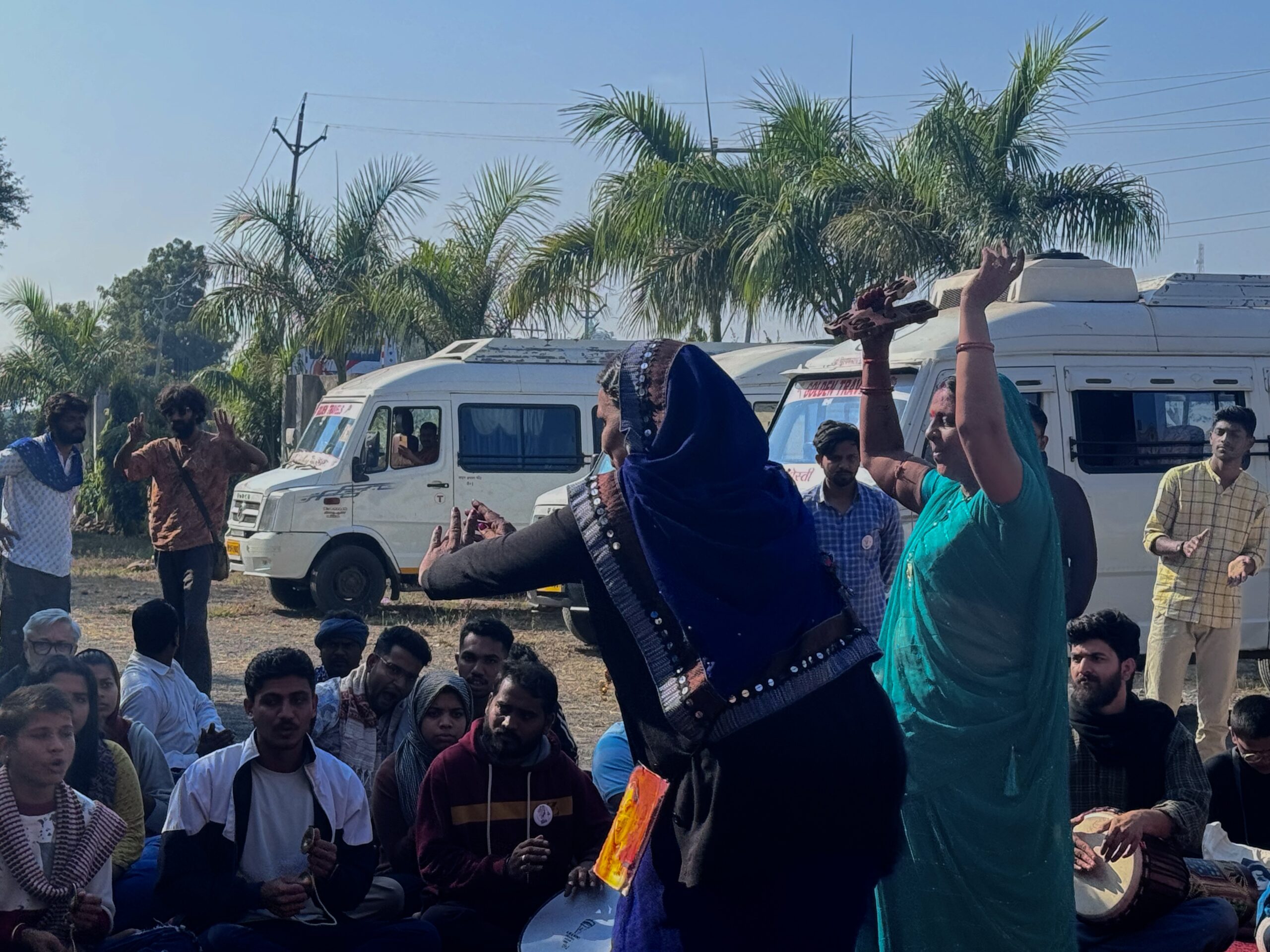
Sharada (left) and Sundarbai dance at the 2024 yatra
Traditional wedding songs, typically heavy with sexual innuendo, began to be frowned upon. Mingling with women from lower castes, bathing openly at ghats, or visiting public fairs started to be seen as immoral. Secular festivals like Teej were no longer celebrated communally. Soon the courtesan communities across North India shifted from being on the margins of ‘respectable’ in pre-colonial India to clearly and utterly ‘other’, that is, corrupting, deviant and obscene. Entire communities of women performers – once highly accomplished singers and dancers – were now simply brothel managers or occupants.
Even in Gandhi’s relatively progressive view of women, courtesans who wanted to join and contribute to the nationalist cause were ostracised. Gandhi called them “more dangerous than thieves” because “…while thieves merely stole material possessions these women stole virtue”, as Dewan quotes from an old newspaper article in her book. Only complete moral and sexual chastity would afford women a chance at real recognition and respect as performers instead of the diligent art practice that courtesans pour their lives into. These views shaped the public perception of female performers in modern India – and continue to do so. Any woman choosing to be seen and heard onstage still runs the risk of being considered morally ambivalent, at least to a degree.
Geeta Parag is one of the most well-known Kabir singers from Malwa. She is usually plainly dressed in dull-coloured sarees with a pallu covering her head when on stage. While most women in Malwa pull their pallu down to cover their faces, Geeta lets us see her face. I once saw her sitting uncomfortably with a group of youngsters who were singing old Hindi film songs. It looked unlikely that she’d sing along even if urged. Later that evening, I asked her if she ever listened to Bollywood songs since they’re so ubiquitous. And if she had a favourite song, one she may have heard on the radio or TV growing up. She said giggling, “I love that song, you know… ‘Haye haye ye majboori, yeh mausam aur yeh doori’ [‘Oh, my crazy helplessness, this weather and this separation’, from the 1974 Hindi film Roti Kapda Aur Makaan].” I was pleasantly surprised as she displayed multitudes of her personality with this unexpected confession, which otherwise her public persona conceals – like the pallus over their heads, dropping back to reveal glimpses of their faces only now and then.
Geeta’s family is Kabirpanthi, like Ambedkar’s, and she started to sing the poet-saint after marriage. Her mother-in-law, Leela Parag, used to sing while working around the house and was her father’s student growing up. At a time when Geeta found herself battling a spiritual crisis, she began singing. What started as humming therapy led to a fierce desire to be on stage, singing out loud for the world.

Geeta Parag (left) at an impromptu performance in Bhopal
Geeta’s husband, Singaram, says that whenever she sang in public he would excuse himself from the audience. “Ye Kabir sahab ke paas jaa rahi thi, aur main ise unse dur le ja raha tha [She was going closer to Kabir, and I was trying to separate them]. People used to say awful things about her, “Paer ki jooti ko paer mai rehna chahiye” [A doormat should remain a doormat]. And so I forbade her from singing publicly out of fear. My grandmother used to sing at home and never stepped up on a stage, she could do the same, I thought then. How could someone need to sing in public?”
But Geeta wouldn’t listen. She received support from her mother-in-law Leela, who too would sneak out of the house to perform at local events and gatherings. Eventually, Singaram gave in and started accompanying her. “Even though men would come to my shop the next day and say that I wasn’t man enough to control my wife. Asking me what was wrong with her,” he says. Geeta continued to sing. Eventually, her husband saw the impact her singing had on people who would walk up to her after a performance to thank her profusely, asking to see her on stage again. He now calls his wife his guru and accompanies her on percussion. But such stories are rare.

Geeta sways to music at the yatra
Kabir and His Utterances
Banaras, the birthplace of Kabir, was also a place where many nationalist forces were taking shape by the late 19th century, polarising Indians based on language, food and place of worship, limiting religious crossover events, fairs and shared celebrations. While Kabir lived, his utterances united people against him. Not surprisingly, it was this quality that got him into trouble as long as he lived, and when he died, a dramatic popularity contest followed between Hindus and Muslims trying to claim him as one of their own. Ironically, in his poems, he often tried to erase dichotomies surrounding identity, in his unique-absurd-dark-humour way, also called “ulatbansi” or upside-down verse that plays with many paradoxes. A paradox like India.
I’m a bowl
I’m a platter
I’m a man
I’m a woman
I’m a grapefruit
I’m a sweet lime
I’m a Hindu
I’m a Muslim
…
I’m nothing
Says Kabir
Like Kabir, Sharada, now a 53-year-old woman, is also full of aphorisms. Things are best explained as a metaphor for all the imports they can hold together. Make of it what you may. When she sings Kabir, it feels like her ‘inner cloth’ is being washed, she says. And ever since the yatra, she insists on taking her love for Kabir further and getting herself a tamboora, an Indian five-string instrument from Rajasthan closely associated with singing Kabir Bani (not to be confused with the tambura used in Carnatic music). But she is struggling to lay her hands on one because tambooras made traditionally are hard to come by, expensive and usually handmade in Rajasthan. But she is prepared to undertake the cross-state journey required for the project.
Not being ‘allowed’ to attend the Mahila Kabir Yatra, Sharada decided that enough was enough. As a mother-in-law and grandmother with a smaller share of domestic duties, she was being kept away from what she enjoyed most – singing. She hatched a plan.
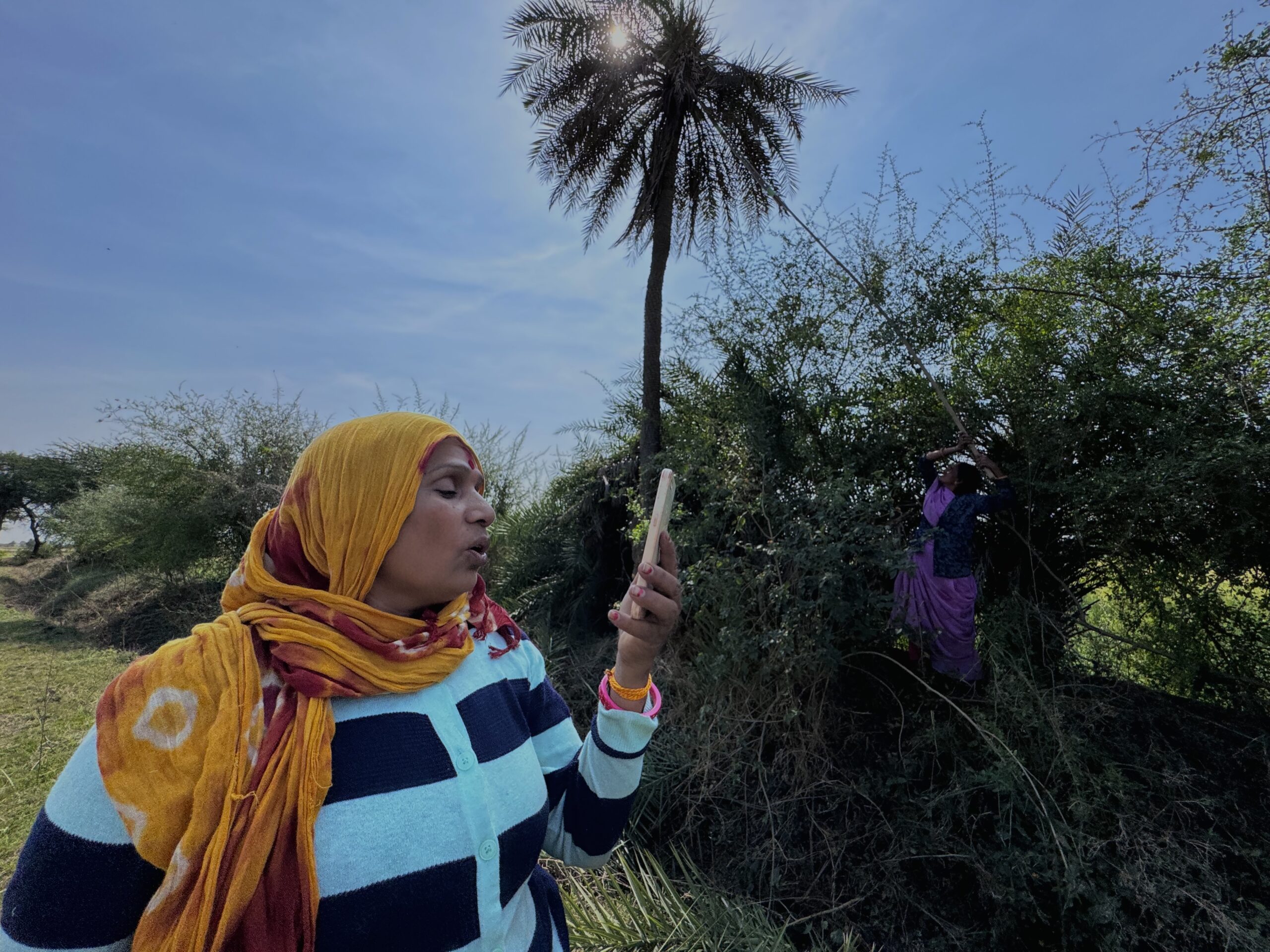
Sharada and Aarti harvesting date palm in Dewas
The pain of losing their perfect mother had affected the sisters tremendously, bringing them even closer together. Without their biggest cheerleader, they had to cheerlead for each other. Gouri, Jyoti and Sharada decided to convince each other’s families to let them perform at the yatra, taking turns to go to each other’s house and pleading with the husbands and in-laws. The Malwa Mahila Kabir Yatra 2023 was the first time all three sisters performed together, though they couldn’t stay with the yatra on all four days. This was the first stage performance for Sharada, making it a turning point for her in more ways than one.
Within the many dichotomies that Kabir presents in his poetry, there is an important and rather puzzling kind, that is between a man and a woman. In his early works, Kabir often called women impediments to man’s spiritual growth, terming them harbingers of trouble.
Nari nasave teeni sukh,
ja nar panse hoi Bhagati,
[Woman destroys three merits,
when she comes near a man]
—
Nari kunda narak ka
[Woman is a pit of hell]
birla thambe baag
Koi sadhu jan ubare,
sab jag moovan laag
[rare is the person who reins in himself]
However, this very troublesomeness becomes almost a jewel-like ornamentation when Kabir the poet becomes a woman in love with his god, his lover, his guru, his Ram, and his Hari, where he uses women’s experiences to describe his desires in great detail.
This paradox is mostly ignored – or even forgiven – in the context of time and history by scholars and performers interested in Kabir for reasons beyond and greater than gender alone, mostly because of the softness with which he takes on the woman persona. Linda Hess, a Kabir researcher and scholar, says that it is not as though Kabir is writing outside of patriarchy. Yet this liminal self-serving confusion is interesting and perhaps opens up receptiveness towards the third gender, with greater spiritual resources for looking inwards and outwards. Perhaps it’s the use of these “female experiences” to texturise love that attracts women to sing to him even today.
In Bhakti poetry, “prem” or love becomes feminine, says AK Ramanujan in his essay “Men, Women, and Saints”, and separation and union with God are seen entirely from a woman’s point of view, making all unions erotic. This conversion, from man to woman, is seen in Sufi traditions too. In comparison, the female saints do not ‘convert’ to come closer to God, as they were already born with fewer cloaks to shed – little to unlearn, barely any power to cede and modest intellectual pride to surrender, making them ideal candidates for love, for bhakti.

Jyoti at sunset with her pile of handwoven brooms in Siya
In March after the Yatra, Jyoti called me to say that she had decided to leave her husband. She wanted to get a room for herself and her kids. She knew very well that her decision would require her to fight her own family but she sounded firm. Her alcoholic husband had found new ways to torment her and she was unable to concentrate on singing. She already spends half her time at her widowed elder sister Aarti’s house. Aarti had nursed Jyoti back to health when her husband abandoned her the previous year. Aarti relies on their dying traditional handicraft to make ends meet and sometimes does not have enough money to even buy a packet of milk. Not wanting to be a burden on anyone anymore, that evening Jyoti made up her mind. An odd job in Dewas, a house where she could do riyaaz on her time, and invite fellow musicians to practise at her place, might fix things. That may well be possible. For the strength Jyoti is capable of, she could shed anything. But unlike the patriarchal view that sometimes Bhakti poets take, women have a lot to ‘shed’; maybe that is why Kabir only becomes a woman in passion-emotion-devotion.
One of the best-known male Kabir singers, Prahlad Tipanya left his marital home including his wife and three kids in the search for spiritual growth at an ashram. Later, his worried parents took his wife and family to him to secure the household, as they feared that their son may stray too far from domestic life and reach a point of no return. Talking about her husband, Shanti Tipanya in an interview to filmmaker Shabnam Virmani, says, “In all his spiritual earnings, I too own a share.” For long, spiritual leaders have been men, as though women are neither spiritual nor leaders, hiding in the background of invisible labour that allows so many men to pursue solitude, often essential for art practice and research. What happens when women do the same?
Hey heli mhari..
[My dear girl-friend]
Surta ko karno hai byah
[My awareness seeks a groom]
Jodika banda na mileya o ji
[I cannot find her a good match]

Aarti makes date palm brooms by hand
A Place for Nirguni Kabir Today

A musician preps his dholak before a performance
Kabir’s poems are still sung all over North India, feature in school textbooks and are recited by musicians big and small, rural and urban, using North Indian dialects ranging from Bhojpuri to Chhattisgarhi to Magahi and more. Purushottam Agrawal, a scholar who has studied Kabir deeply, says that Kabir lives on because he is primarily a poet of love and longing. It is us [artists and activists], Agrawal says, who insist that he be more by turning him into a social revolutionary. Ambedkar, too, during the Constituent Assembly debates, reminded us of how fraternity (love) was the most important Constitutional value that would safeguard all other values. And so like love, the limitless landscape of Kabir Bani invites us, inside the swara (musical note) for a sustained thoughtful engagement.
When asked what the biggest takeaway from engaging with Kabir should be, Agrawal says that he reminds us to question all authority – including Kabir Bani – and make thinking and reflection the basis for our existence. In a famous bhajan, Kabir sings,
Nirbhay nirgun gun re gaunga
[Fearlessly formless, that’s the form I’ll sing
I’ll sing, I’ll sing!]
…
Shunya shikhar par anhad baje-ji
Raag chattis sunaunga
[On the peak of emptiness
where the unstruck sound resounds,
I will sing thirty-six ragas]
Linda Hess says, about the eminent musician Kumar Gandharva’s rendition of this bhajan, “Reading about it [the bhajan] is not necessarily moving, but the song!” Therefore, Nirgun is in the experience of life and not in the definition of it. Usually translated to ‘attribute-less’, Nirgun is what lies beyond description. It is the state of being empty, shunya (zero), sometimes existing in silence, a place to live and die, to sing and surrender at the same time, in Hess’s words. Nirgun is Nirbhay [formless is fearless]. She says, that “one is so free that one’s joy cannot be contained — it’s boundless.” This reminds us of the pleasure of deciding – I will sing, yes, I will sing, oh I will sing, asserting and repeating endlessly what feels good, which is also one of the explanations of the term ‘bhajan’; to reiterate what is important, like the god’s name, with great pleasure.
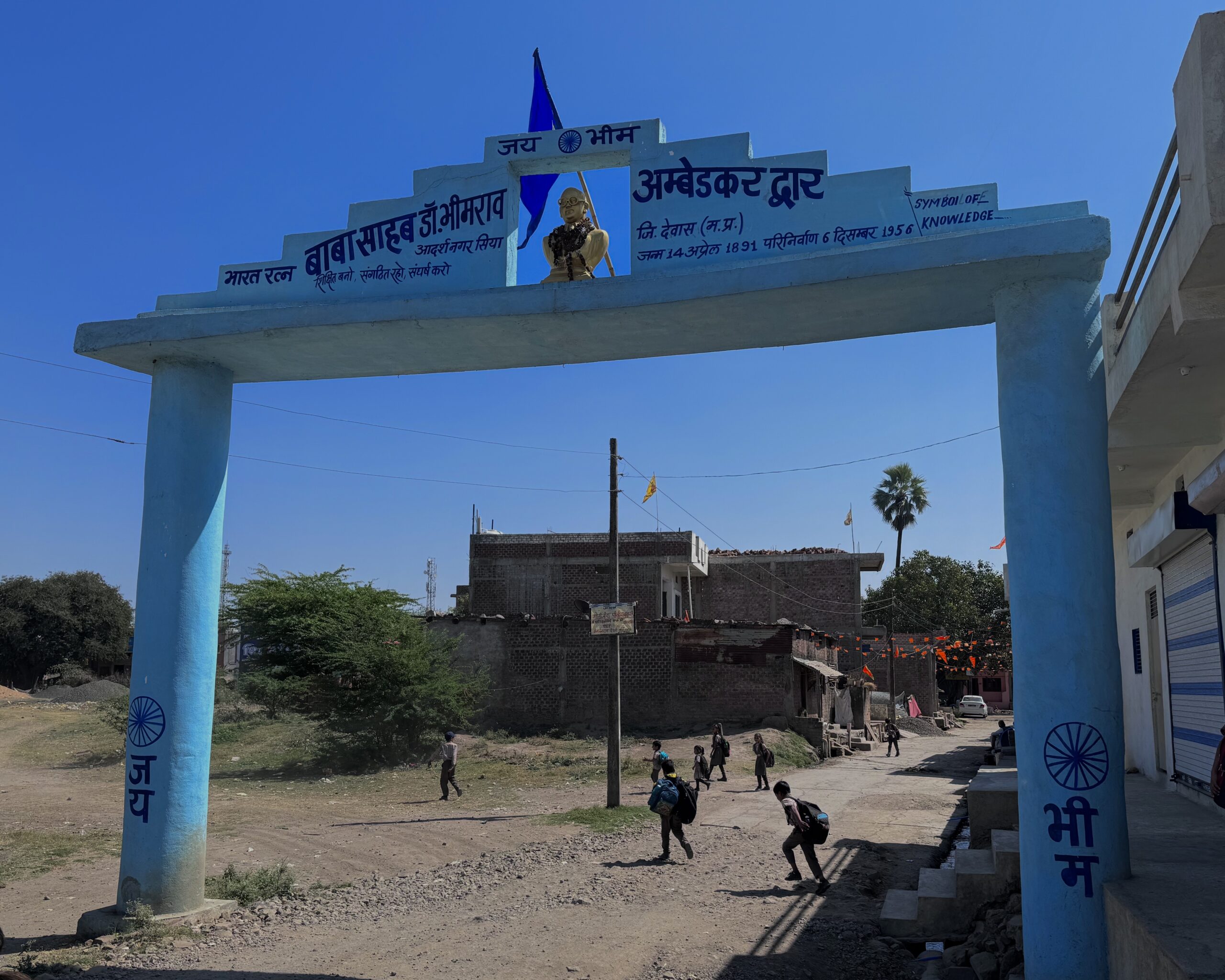
The ‘Ambedkar Gate’ entrance to Siya village
When I first called Jyoti over the phone, her caller tune ran a famous melancholic Bhupen Hazarika song, “Dil hoom-hoom kare, ghabaraye, ghan dham dham kare, kharaye. Ek boond koi paani ki mori akhikon se barsaye” [My heart pounds, the clouds gather to thunder and make me cry a tear]. The song is from the 1993 Hindi film Rudaali, a title that translates to ‘weeping woman’. Jyoti felt like a person after my own heart. This is the first time that Jyoti had a personal phone after she was forced to buy one six months earlier after her old teacher, Kaluram Bamaniya, scolded her for not being more serious about restarting her journey to the stage.
What do you do when you are not allowed to talk? You listen, you observe. The quieter you become, the better you can hear. Kabir Bani would have travelled through homes and public spaces even when new embargoes were being set up for women back in the day. The empty yet powerful life forces of Nirgun poetry grip those paying close attention, looking for answers, especially when hummed. Kabir observed and questioned, and his paradoxical wordplay stayed with you, sometimes as explanations of the absurd ways in which our world works. The rare quality of Kabir’s poetic commentary must have attracted questioning minds beyond gender and passed on orally and informally amongst women. After all, the faculty he used most was common sense. A rare commodity in any era.
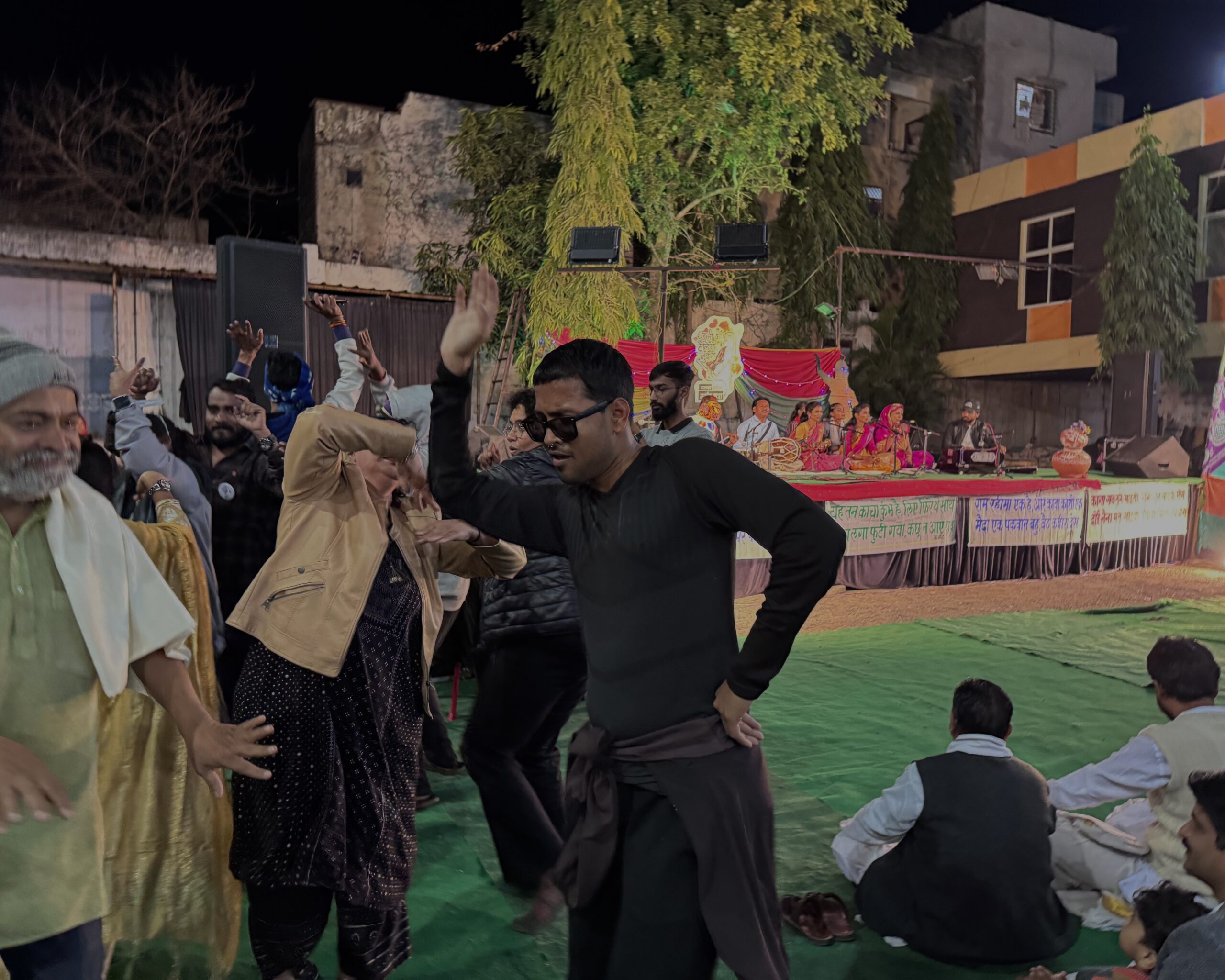
Members of the audience dance to the Banjara Sisters at the Yatra
Nirgun feels like a nihilistic idea at first, because of its ability to invite us into observing the arbitrary line between abstract and concrete. The nirguni guru (god) thus cannot be set in stones, scriptures or sermons, and doesn’t have one name. It does not enable division. Only inviting surrender. Emptiness unites us by existing in nothing, and then in many things at the same time – like the rain, the leap of a frog, bird song, the silence between swaras, or gestures of love. You will feel it when it comes. Kabir often called his Nirguni god “Ram” and “Hari”, defining four versions of Ram, which can also serve as a description of a formless Nirguni god:
Ek Ram Dashrat ka beta
(One Ram is the son of Dashrat)
Ek Ram ghat-ghat mai baitha
(One Ram sits inside all of us)
Ek Ram ka sakal pasara
(One Ram expanded life’s creation)
Ek Ram hai sabse nyara
(One Ram is above and beyond this)
The Ram that is above and beyond is the Ram that Kabir longs for in union. He is not the ‘maryada purushottam’ (perfect man) of mythology and popular piety, but a Ram more transient, next-door and accessible. But to see and experience this Ram or Hari, one has to dig them out of their particular rabbit holes of experience. Bhajans or poetry can only get you started on the journey, and very likely we will be drawn to define, name and assign value as they have been ingrained in us. Sharada says that when she is singing, she sometimes enters a trance-like state where she can see herself emptying out her other self(s). This is the reason she sings. She starts to feel hot with passion and eventually feels cool, very cool. Singing Kabir is like coming home after a long journey, she says.
Women and Kabir
There are many stories about how Kabir castigated casteism. Since Kabir was a poet inviting dialogue and truth-seeking, “Kahat Kabir suno bhai sadho” [Kabir says, listen fellow truth-seeker], sometimes provocatively, the kind of expression we seldom find acceptable today, and so to learn from Kabir’s India, it is important to not retrofit him into our times, politics and language directly. Kabir was responding to a different version of the State vis-à-vis his challenges of citizenship. Coming from the margins of society, Kabir became a powerful social ‘influencer’ because he questioned what he saw around him, not just about his status in society but about the state of affairs, speaking truth to power unsparingly, repeatedly and getting reprimanded for it. He would be a problematic figure if he were alive today. Maybe this is why singing Kabir today is a radical act.
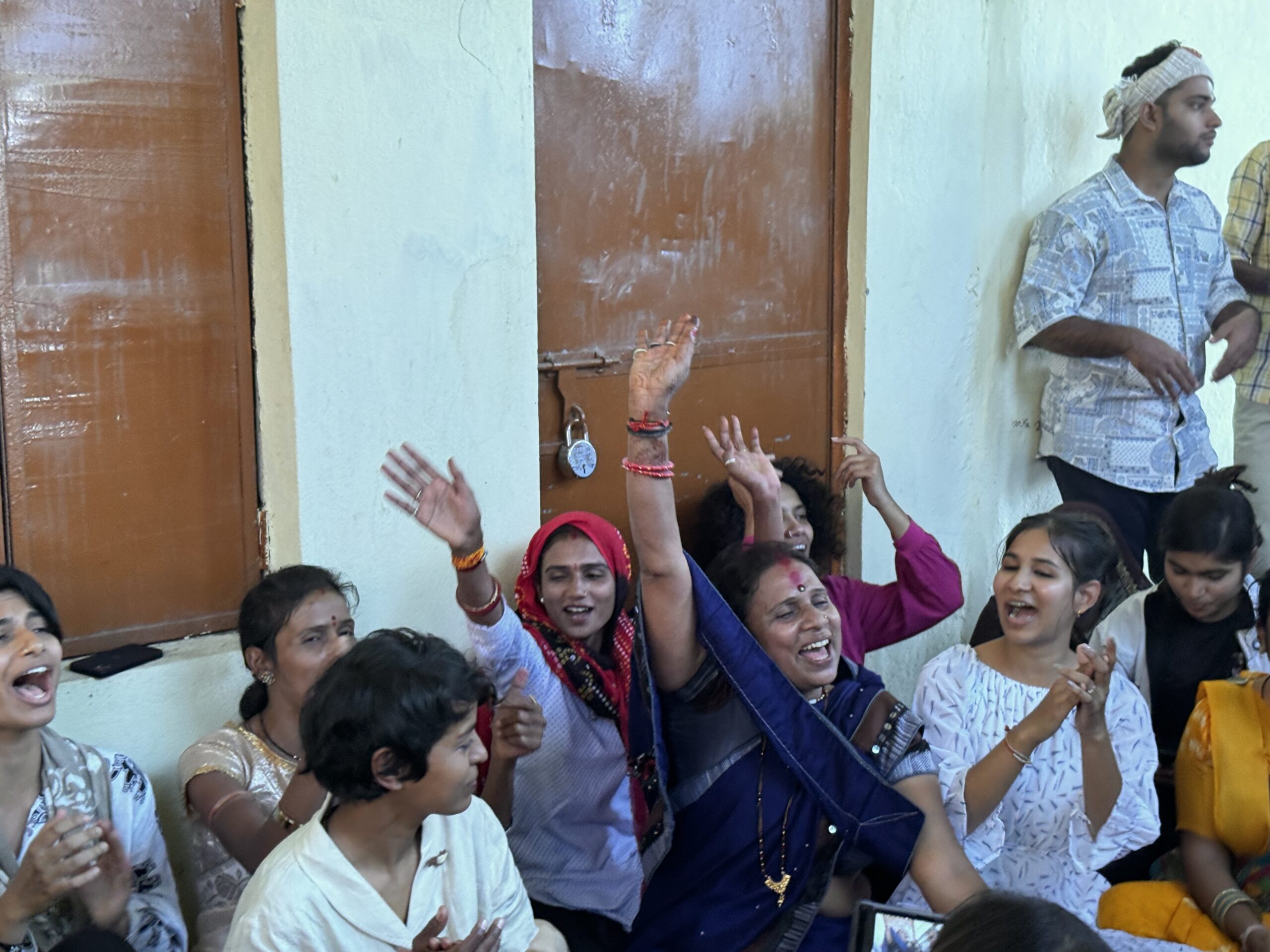
Sharada, Gouri and Jyoti performing off stage at the Yatra
Guruji mai toh ek nirgan dhayu ji
[I meditate only on the one,
The markless one]
Duje ke sang nagi jaungi
[I don’t keep company with any other]
…
Ganga na jaun ji, Jamuna na jaun ji
[I won’t go to Ganga or Jamuna]
Mai na koi teerath nahaun ji
[Won’t bathe in holy waters]
Arsat teerath hai ghat bheetar
[Inside me there are sixty-eight holy places]
Vahi mai mal-mal nahaun ji
[I shall wash all my stains right here]
Ambedkar considered Kabir one of his three gurus, alongside Gautama Buddha and Jyotirao Phule. Ambedkar is said to have come from a Kabirpanthi family which considered Kabir their God and Kabir’s utterances as their sacred text. Kabir Bani also found its way into the Adi Granth, the first sacred book of the Sikhs that has more Kabir Bani than of any other bhakti poet-saint. In his speech, ‘Annihilation of Caste’, one can hear Ambedkar channelling Kabir. And so one finds that in many organised public performances of Kabir, a mention of Baba Saheb Ambedkar on flex banners alongside Kabir and “Jai Bheem” following “Saheb Bandgi” [We are tied to the true god] follow as continued greetings.
However, at places where Kabir seems to be alive and thriving, women seeking public engagement are forced to lurk in the background. While a few women of privilege have been singing Kabir bhajans, most women in the Malwa still rely on accidents of birth to receive this introduction. The Bhajan mandlis that perform in Malwa are often made up of only men. Women are seen in small numbers in the audience. And women who want to sing on stage are given a spot right at the end of the programme, if at all, once most people have left. Moreover, men often leave when women get up on the stage. Those who dare to continue performing on the stage are defamed and disrespected openly by their own family and community members.
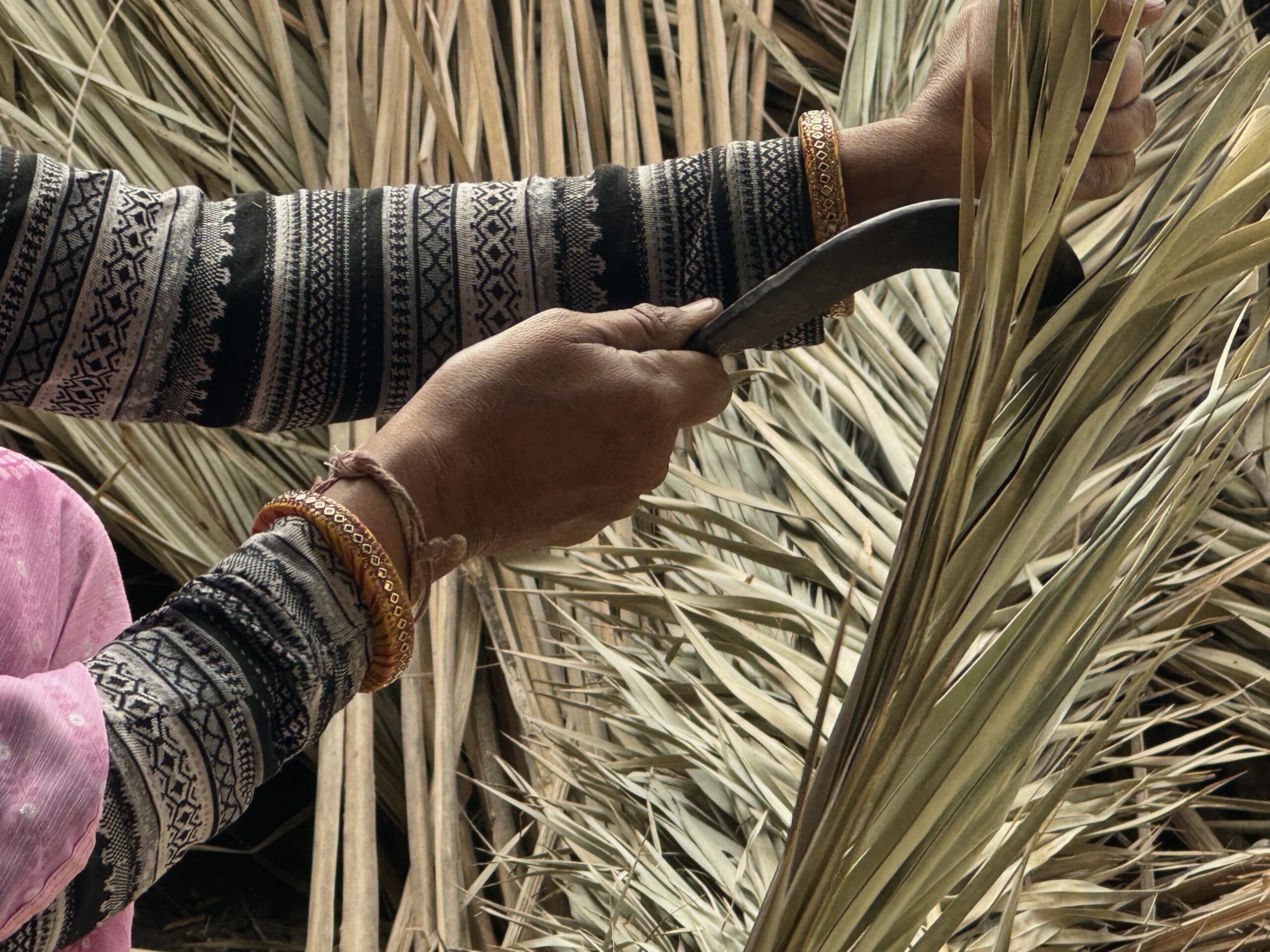
Jyoti pruning date palm leaves
In her book Singing Emptiness, Linda Hess talks about Kumar Gandharva performing the poetry of Kabir. People who knew Kumar say that he lived a deeply attentive life, paying attention to birds, picking vegetables for the day and watering the plants precisely. Surely all of this nurtured his music. Most women I know are extremely attentive in everything they do. Mending, feeding, working, caring, thinking, cooking and looking, all take a great deal of attention. If the quality of abundant consideration takes a poet from good to great, listening and observing more than you speak, that should mean most women are poets already. But what links one to Kabir? In Kumar’s case, it was his proximity to death. Not being able to sing all those years of sickness (he contracted near-fatal tuberculosis) must have fostered a special kind of melancholy. Kabir says,
Mai rouvi ya jagat ko
(I cry for the world)
Moke rove na koye
(The world doesn’t cry for me)
Moku rove woh jana
(the one that will cry for me)
Joh shabbd viveki hoye
(will be the one who cares about words)
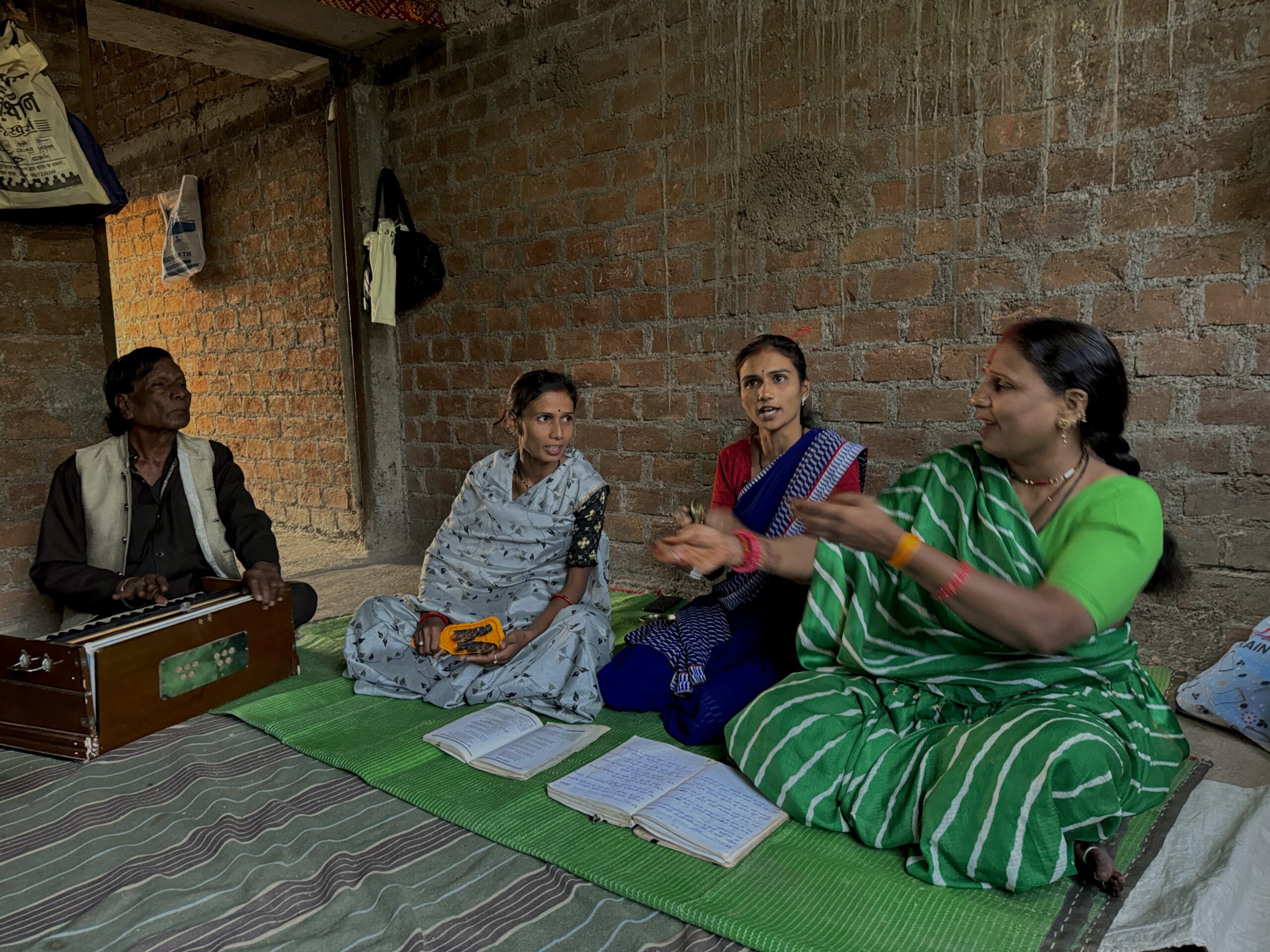
The Banjara Sisters learning their father’s bhajans
Kabir was a poet of a purely oral tradition; his poems travelling as songs made engagement with his work as available to an illiterate woman as to a learned priest. While his words can be in turns paradoxical, critical and satirical, they also invite and urge those singing and listening to cultivate consciousness. Although women may have been kept from singing loudly under a tree urging active engagement with an audience, they must have sung, thought, reflected, composed, questioned and arrived at emptiness, at knowledge, resistance, carrying the essence of Kabir forward. This is why women in Malwa still sing him, elevating him through the medium of swara, decoding the poet-saint to fit their lives, and now fighting to sing him up on a stage, openly.
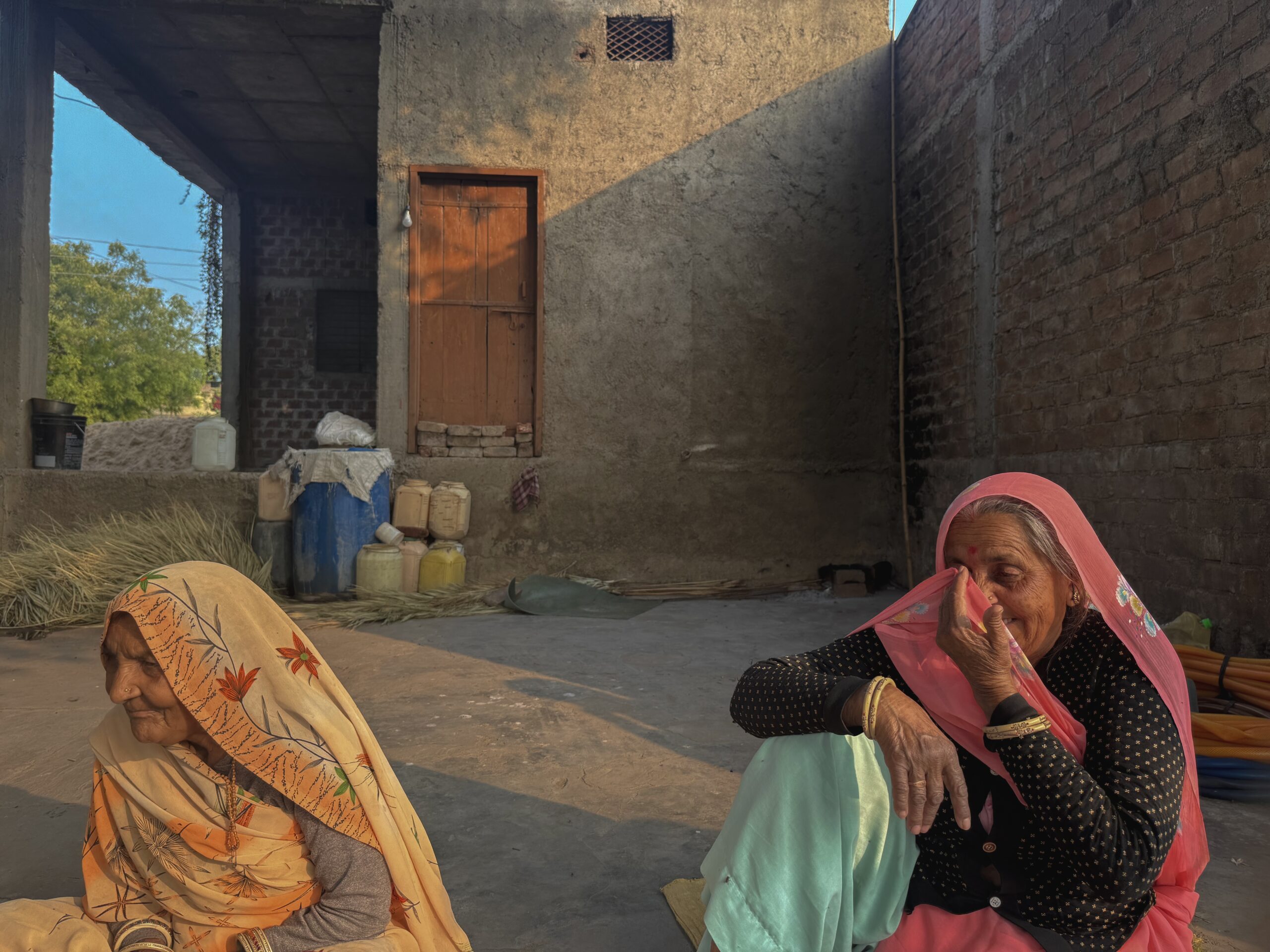
Women listening to the sisters sing are moved to shed a tear or two
Around 2007, researchers like Hess and Virmani, who studied Kabir’s living oral traditions in Malwa started asking the question: Why weren’t women singing Kabir on stage? Responding to this disproportion, where they found women either singing inside the constraints of the four walls or only for a female audience, the researchers along with the Eklavya Foundation decided to start an initiative to make learning Kabir more accessible for women and children. Between 1991 and 1998, the Eklavya Foundation ran a monthly forum on Kabir, inviting bhajan mandlis to absorb Kabir beyond just singing him through sustained dialogue. On the second day of every month, local singers were invited to sing. The stage was open to anyone and everyone interested in singing or talking about Kabir. And so, this appeared like an important extension of their work, and members from the forum came forward to spearhead this program as teachers and organisers.
This initiative reached Gouri and Jyoti in 2010 through their father who became a full-time musician after retiring from his government job. For the first time outside the confines of family and the guru-shishya parampara (traditional student-teacher practice), women and children began learning not just singing but also performance from male singer-performers of Malwa. Soon after the program started, Jyoti got married (in 2012) and wasn’t allowed to sing. Gouri also gave up singing after moving to her marital home in Indore shortly after.
It was assumed that the sisters wouldn’t sing on a stage again. A combination of domestic duties and financial burdens kept them off-stage for more than a decade. Jyoti took up a job as a temple cleaner in Ujjain, often standing and mopping the floor for eight hours at a stretch. Gouri took up odd jobs to supplement her husband’s income to manage their city life. Kaluram Bamaniya, their guru from the program, calls this unfortunate as his students who showed great promise had to give up their dreams because of marriage. He wishes they had fought harder to keep their passion alive. His daughter is now an upcoming Kabir performer, and he just won a Padma Shri award for his singing.
Sharada, as the second eldest sibling, was already a grandmother by 2018. When she got married 40 years ago, she used to sing at family poojas in her neighbourhood in Ujjain, but mainly devotional songs. Her brother-in-law had a problem with her singing “in public view”, and she was asked to sing only at home. Years went by. Sharada, who was by then almost desperate for the freedom to sing and dance, started going to temples and pleading with the gods to let her sing. A Kabir temple inside a crematorium seemed to have registered her prayers, and she was asked by the management to sing there regularly last year, where she still sings every Wednesday.
Sharada says that most women around them are not allowed to step out of their house. “We are often told that if it is devotion you want, why go outside seeking it? Look for it inside the house and yourself.” Sharada was introduced to two more women singers, at the Kabir temple, both of them in their late 70s. The strength in their voice will shock you, she says. You won’t believe that they haven’t been trained formally. And their devotion to Kabir is unheard of. Yet, the only time they get to leave their house is on the full moon to perform at the Kabir temple. Together they call themselves ‘dukhi mandli’ (sad ensemble) mitigating pain through their choice of songs and singing. The three women are now inseparable and call each other their chosen family.
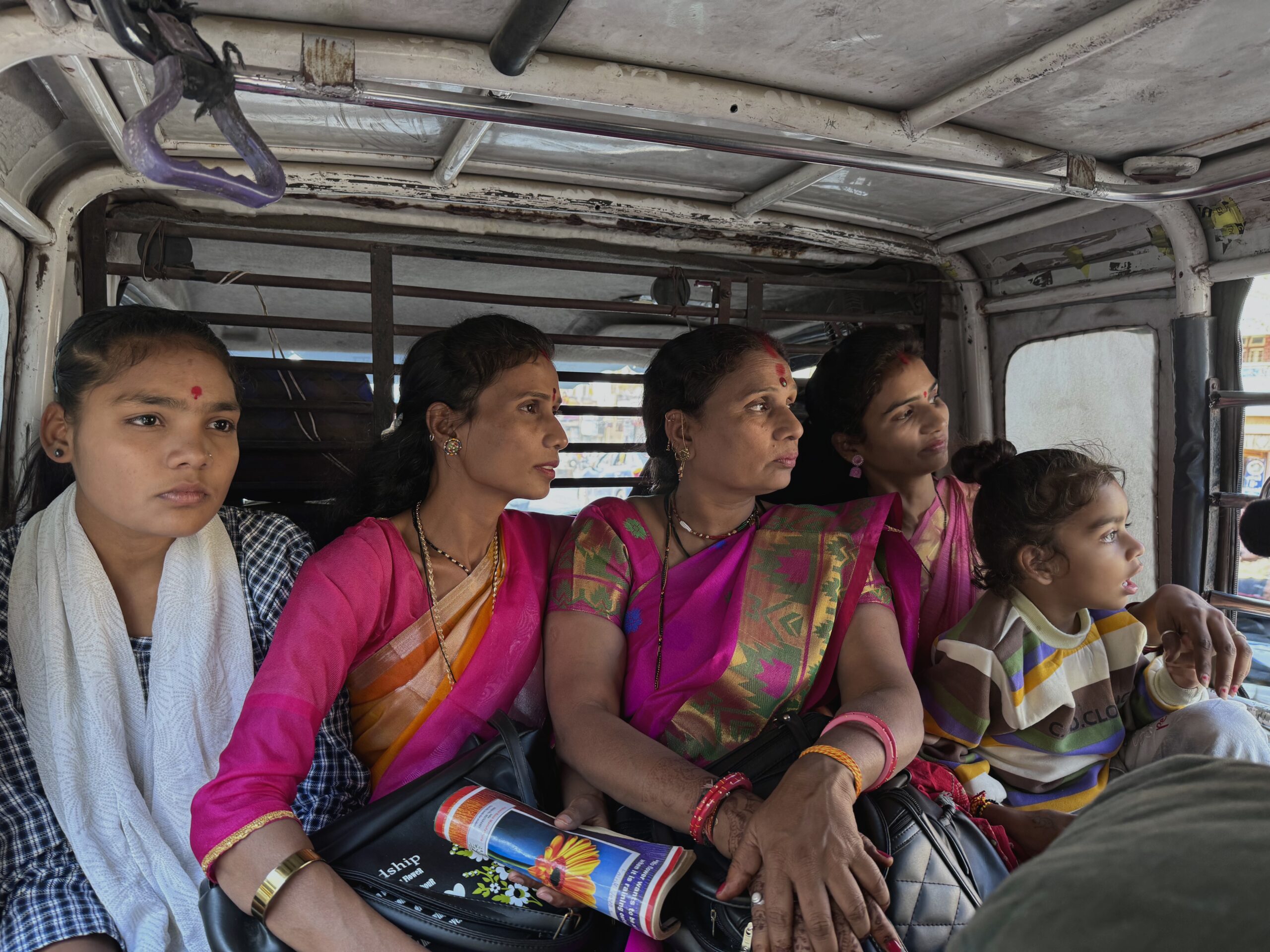
Jyoti, Sharada and Gouri travelling to the Yatra
When, in 2023, the first Malwa Mahila Kabir Yatra was announced by the Eklavya Foundation, old lists of female Kabir singers of Malwa were sought from the monthly bhajan mandlis’ program coordinators. When Jyoti and Gouri got a phone call inviting them, they couldn’t believe their luck. At the time, Jyoti was recovering from a severe case of typhoid and had been abandoned by her husband’s family because of what her in-laws justified as severe financial constraints and inability to afford treatment. In her dark days which she thought she may never return from, this phone call was a sign, a way out of a bad marriage, a chance at life. They invited their elder sister, Sharada, to sing along with them, even though she hadn’t been trained in nirgun. Their father, for the first time, supported the sisters’ bid to be on stage and helped them prepare for their yatra performance.
Something special happens when women on the margins sing Nirgun. Inside the outline of ‘devotion’ that makes public participation of women possible, when the shapeless, attribute-less form of Nirgun strikes, a powerful exchange happens. In Sagun (‘with form’), the divine in its absolute form appears concrete and formidable. And so the devotee has little room for manoeuvre. It is what it is. Take it or leave it. But the Nirguni God is open, not formed. The devotee matters when they look for the divine. So when Sharada, Jyoti and Gouri perform a bhajan calling themselves banjarans (nomads), asserting their love for the ‘guru’, calling to men to throw their anger and lust into the burning pot of fire, while off stage they live a life of social restrictions and domestic control, one feels a sense of regained control. A question of possibility. A prayer for freedom. Registering their reproach publicly. Mai Banjaran Ram ki was the first Nirguni bhajan they learned from their father around 2008. This bhajan helped the sisters restart their singing journey after the YouTube recording of their song got thousands of views. And this bhajan gave them their group name: the Banjara Sisters.
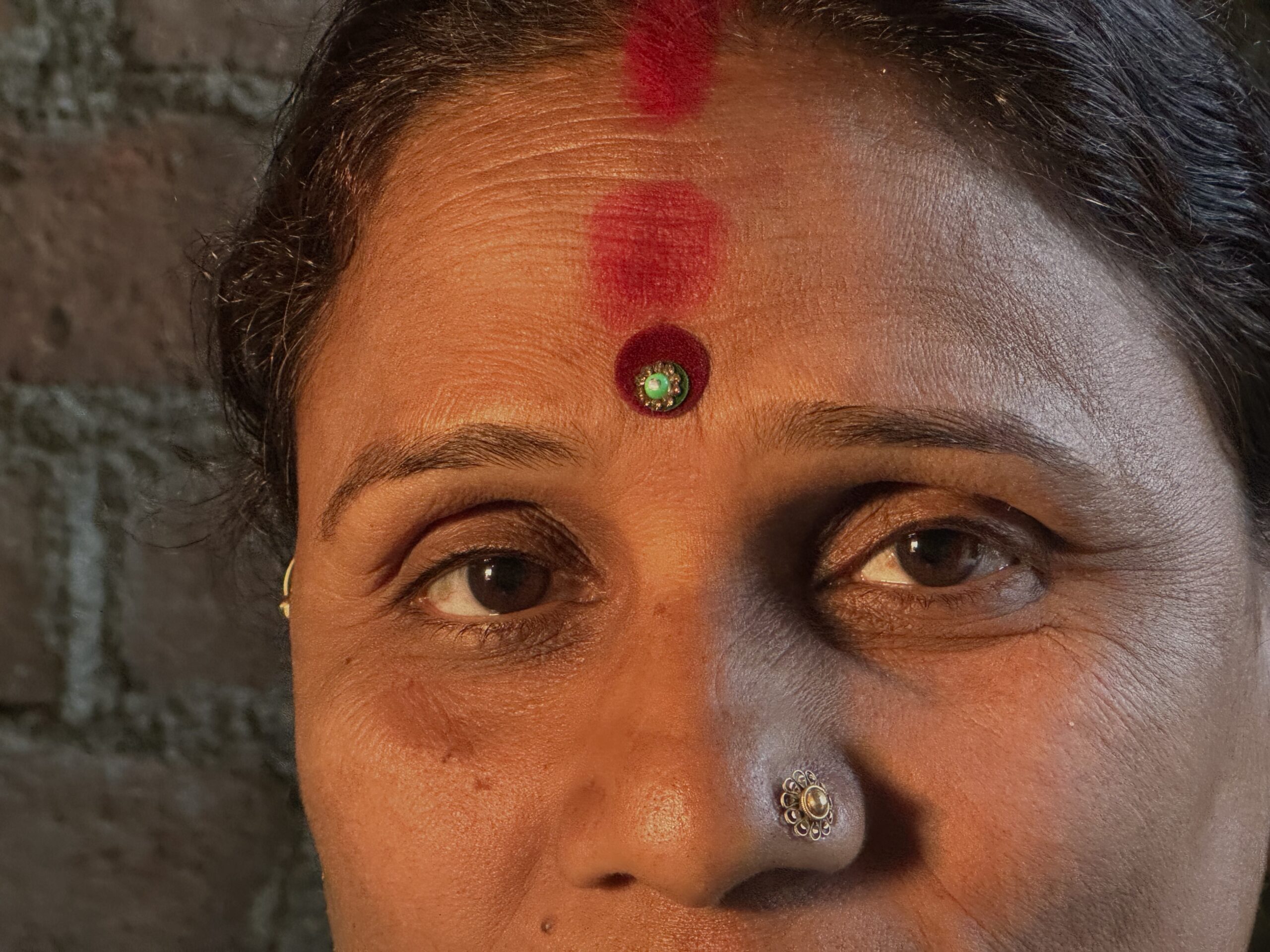
Sharada’s two bindis: one for marital harmony, the other for the Divine Mother
Marriage introduced the sisters to new gods. Their house in Siya is inside Ambedkar Nagar, housing Dalits (including Kabir Panthis), Muslims and a few land-owning upper-caste Hindu Thakurs. The sisters are famous in the village for their singing and are remembered as ‘good girls’ who married into good families. Initially a devotee of ‘Ma’ (a form of the divine feminine), Sharada moved to Ujjain, a Hindu pilgrimage destination, and discovered Mahakal (Shiva). Jyoti moved to Krishna. And Gouri is now an ISKCONite, making her meals without onion and garlic (but which she loves to return to when back in Siya).
This year, the sisters were present for the entire duration of the four-day yatra, eagerly participating in discussions, dancing and singing on and off the stage every day. Gouri was able to convince her husband to attend the Yatra, who also took care of their four-year-old son while she performed. Sharada had her husband in the audience for the first time, where he recorded the entire performance on his smartphone. Jyoti’s husband refused to come, but her children attended the Yatra and cheered for their mother. Again, because most Kabir yatras do not give the artist performance fees, it is difficult for extended family to attend.
Sustaining Art Practice

Sharada and Aarti on their way to harvest date palm
Despite being star performers at the two yatras, sustaining their art practice remains difficult. There were no stage performances in between. And so no income from performance. The sisters often meet at their maternal house for joint riyaaz and learn from their aloof father. But there are always problems – as when a rat gnawed at the insides of their harmonium. Now money must be saved to get a new one. But the sisters continue to dream, to live the fabled nomadic life of performing artists, touring new towns and cities, wherever everyone recognises them as ‘kalakaar’ (artists).
Jyoti talks about how the opportunity to sing bhajans on stage gave her the will to fight for her life, hoping to leave her husband and offer her children stability. But in her second innings, Jyoti finds herself lost. She survives on the money that her sisters give her when they have any to spare. Her nine-year-old daughter had to drop out of school because there was no money to pay the fees. Her husband expects Jyoti to give him the little money she makes from local performances, which usually only covers her travel costs. She constantly worries about her children back home who she knows aren’t taken care of by her husband.
When I once asked her about how she felt about a certain bhajan, she said, “Pehle sab feel hota tha, par aaj kal dimaag mein bas yeh chalta hai ki bacchon ke school ke paise kahan se aayenge” [I used to truly feel what I was singing initially, but now all I can think about is how I will pay my children’s school fees]. Marriage is the biggest reason behind women exiting the workforce in India. Had marriage not been the single most important social event of the Banjara Sisters’ lives, they would have got the attention and the training they deserved, as their brothers did. Both received training from their locally famous father formally and also had music teachers growing up. They now hold jobs in the field of music. A family inheritance of music remains unequally divided, but so does passion for singing.
Right after the second Malwa Mahila Kabir Yatra in 2024, the sisters went to their maternal house to help Aarti harvest date palm leaves for the brooms they would make and barter for enough wheat to last them a year. That means making two thousand or more brooms by hand. Men traditionally did the arduous task of cutting the leaf from the tree, and women handled everything else with the making of the broom. But Bhagvanta Bai’s family is different; all nine women handled this traditional practice alone while their father travelled frequently for work in the morning and to perform at night. Date palm leaf harvesting is an exhausting, labour-intensive activity. And then to make time for art practice is incredibly challenging.
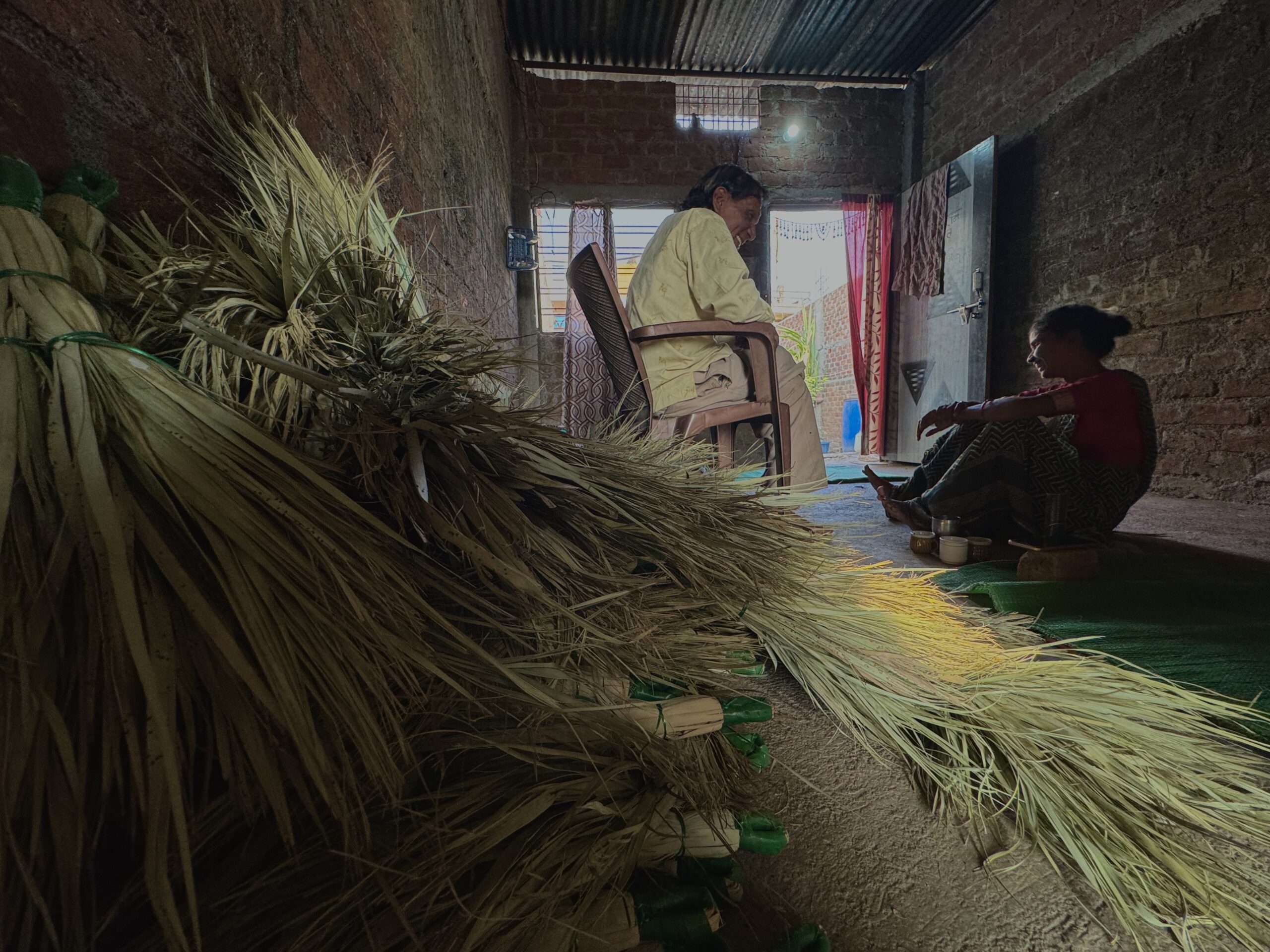
Jyoti and her musician father
A special thing about Kabir (and other Bhakti poet-saints like Ravidas and Dadu) is their everyday vocational practice. They were not godmen, priests, or heads of state. They were tailors, cobblers, weavers, and farmers – working-class people who ended up being philosophers revered as saints. In their poems, they repeatedly point out that their vocation is heavily linked to caste divisions in India. They insist on how there is no spiritual/abstract without the domestic/everyday/concrete. They are inseparable. This should mean those who engage more closely with the domestic must be working their way towards the truth more keenly, like women. But the female artist perfecting her craft is often invisibilised, compromised and uncelebrated.

The Malwa landscape and the disappearing date palm trees
Many Nirguni singers whom I interviewed equated singing with crying, containing healing and cathartic properties. During one of the morning Tatsangs at the Yatra, we spoke about dealing with pain. Sharada shared with us a song she wrote for her ‘“lost mother”, as a way to express her grief at having lost her closest confidante. Every person in the room was teary-eyed. It opened up a conversation about all that we have lost and are losing collectively, among an extremely diverse social group of yatris, a rarity just like Kabir, enabled by Kabir. We felt released from ourselves for a few seconds and connected. With an awakened spiritual self, all feeling grateful to be there, united under a name and pain. While pain is inherent to being a woman, to be able to turn that into art is a luxury few enjoy.
Meanwhile, even as Kabir’s words and ideas are kept alive in small rural hamlets by new groups of devotees such as the Banjara Sisters, the paradoxes live on too. In March 2024, the sisters were invited to Ayodhya to perform at one of the cultural stages set up at the under-construction Ram Temple. Paradoxical yet precious. This was their first-ever paid gig – forty thousand rupees including travel. This was also the most they have ever been paid. To be noticed by a government body is important for any artist, but especially for women, who are too far and few in between even on a ‘national stage’ that should be consciously reserving space for those who haven’t historically had the chance to tell their story. It is crucial to note also how their Dalit identity has kept them out of the very spaces that are now inviting them to perform. Growing up, the sisters were denied entry into temples, kept from using the village handpump, and barred from entering their upper caste friends’ homes. So much so that they now hide their food habits, occupation and other details that make them seen as non-upper caste.
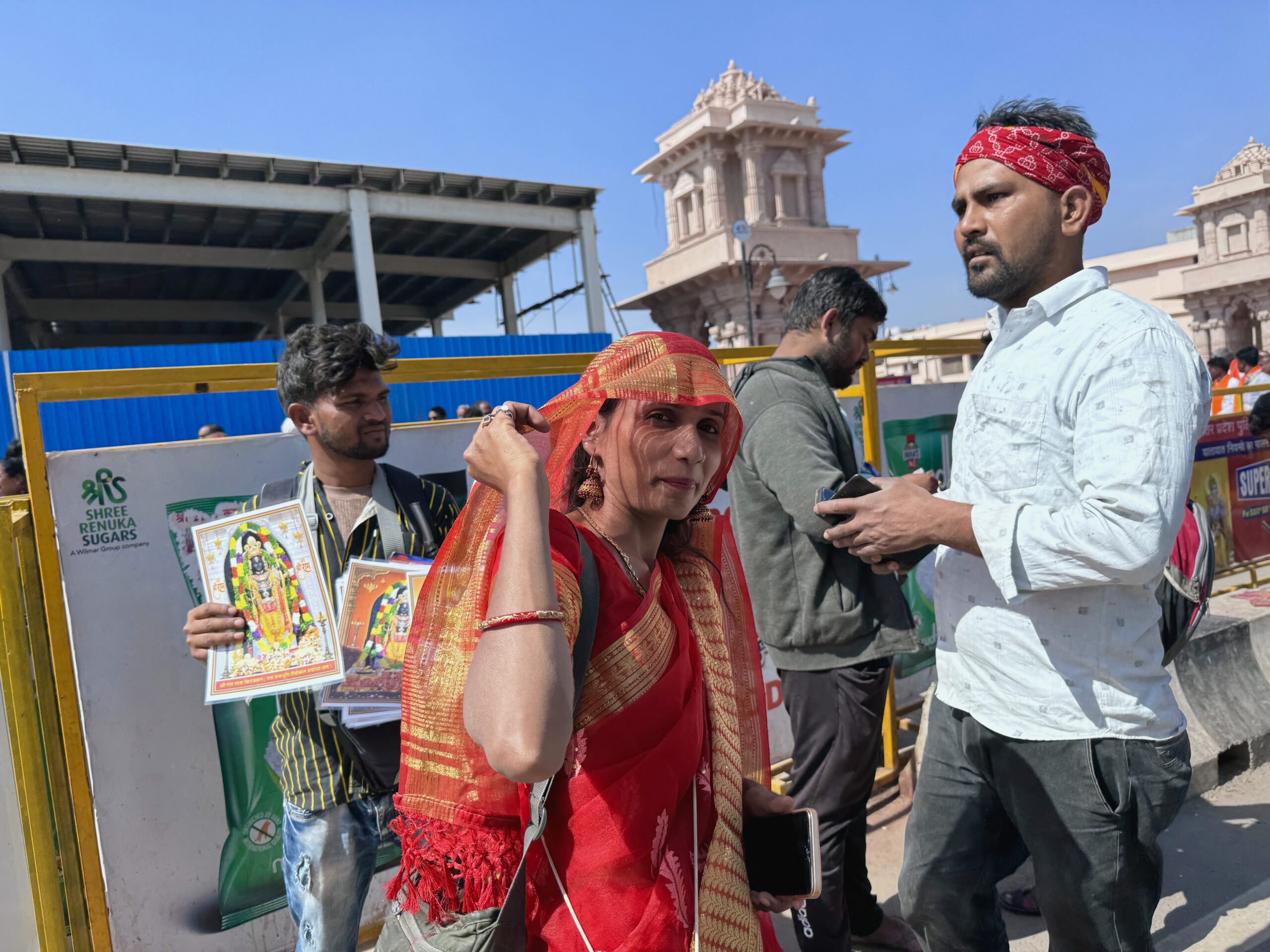
Jyoti outside the newly built Ram temple in Ayodhya
Without any defined trajectory of how the Banjara Sisters are going to grow as an artist group, they continue to knock on any doors that seem friendly. They carry individual aspirations beyond the group. The kind of opportunities that come their way will shape them as artists. Gouri is keen to sing qawwalis. Jyoti wants to be able to explain the meaning of her favourite bhajans to others and learn to play the violin. And Sharada wants to sing Meera Bai on stage for the next yatra. Programs like the Mahila Kabir Yatra do help, by giving a platform to marginalised voices, but women performing artists will continue to struggle to make their voices heard in a man’s world.

The sun sets in Siya
Bibliography
- Ajab Seher, https://ajabshahar.com/featuredcontent/, Accessed on January 30, 2024.
- Agrawal, Purushottam (2021). Kabir Kabir: The Life and Work of the Early Modern Poet-Philosopher. New Delhi: Westland Publishers.
- Mehrotra, Arvind Krishna (2010). Songs of Kabir. New Delhi: Hachette.
- Hess, Linda (2021). Singing Emptiness. Trans. Kolkata: Seagull Books.
- Dharwadker, Vinay (2004) “On Women Saints” and “Men, Women and Saints” in The Collected Essays of A.K. Ramanujan, London: Oxford University Press.
- Dewan, Saba (2021). Tawaifnama. Delhi: Context Publishers.
- Sethi, Ali (2014). “The Djinn of Aiman”. The Caravan. Source: https://caravanmagazine.in/reviews-and-essays/djinn-aiman, Accessed on February 19, 2024.
- Prasad, Shishir (2024). “Kumar Gandharva, the lord of the ragas”. The Economic Times. Source: https://economictimes.indiatimes.com/news/india/kumar-gandharva-the-lord-of-the-ragas/articleshow/109094799.cms?utm_source=contentofinterest&utm_medium=text&utm_campaign=cppst. Accessed on April 29, 2024.
About the Storyteller
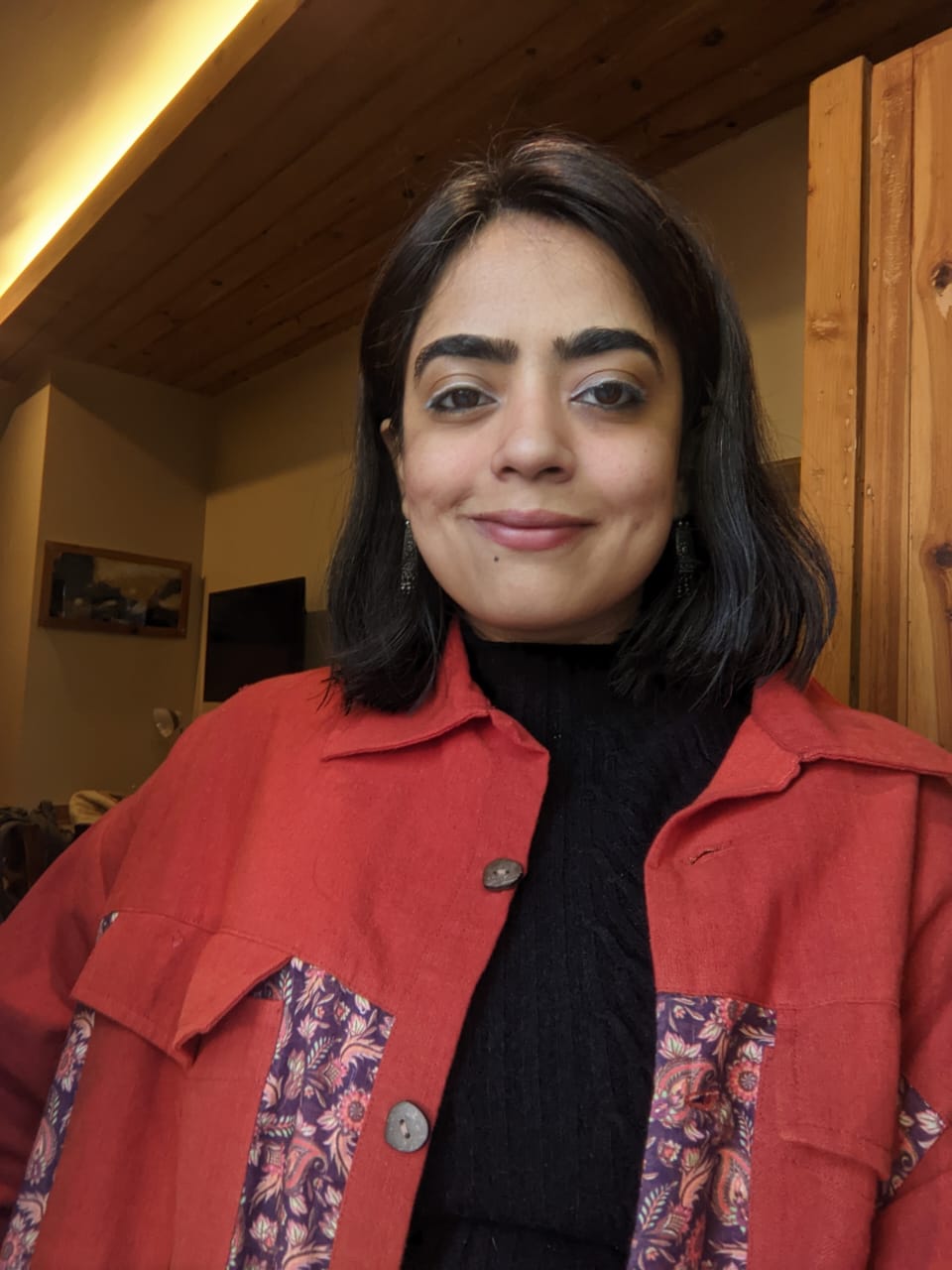
Tanvi Jadwani
Tanvi is a journalist turned social worker turned film-maker. She is interested in documenting the unseen female experience and does it through a multi-disciplinary art practice.